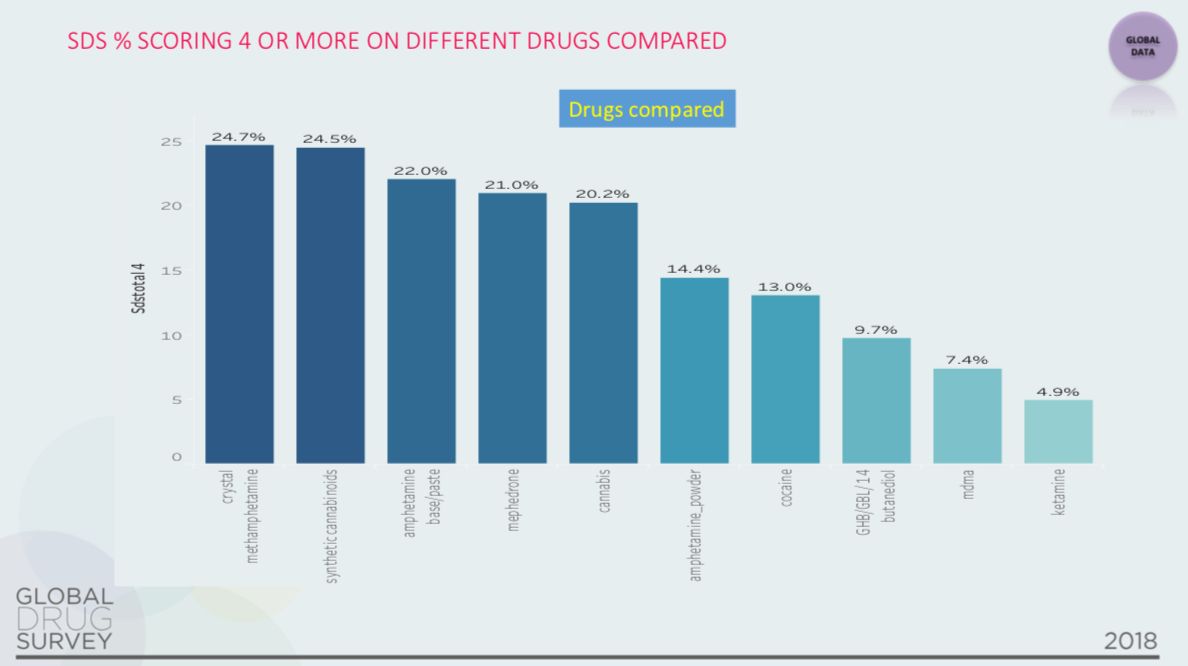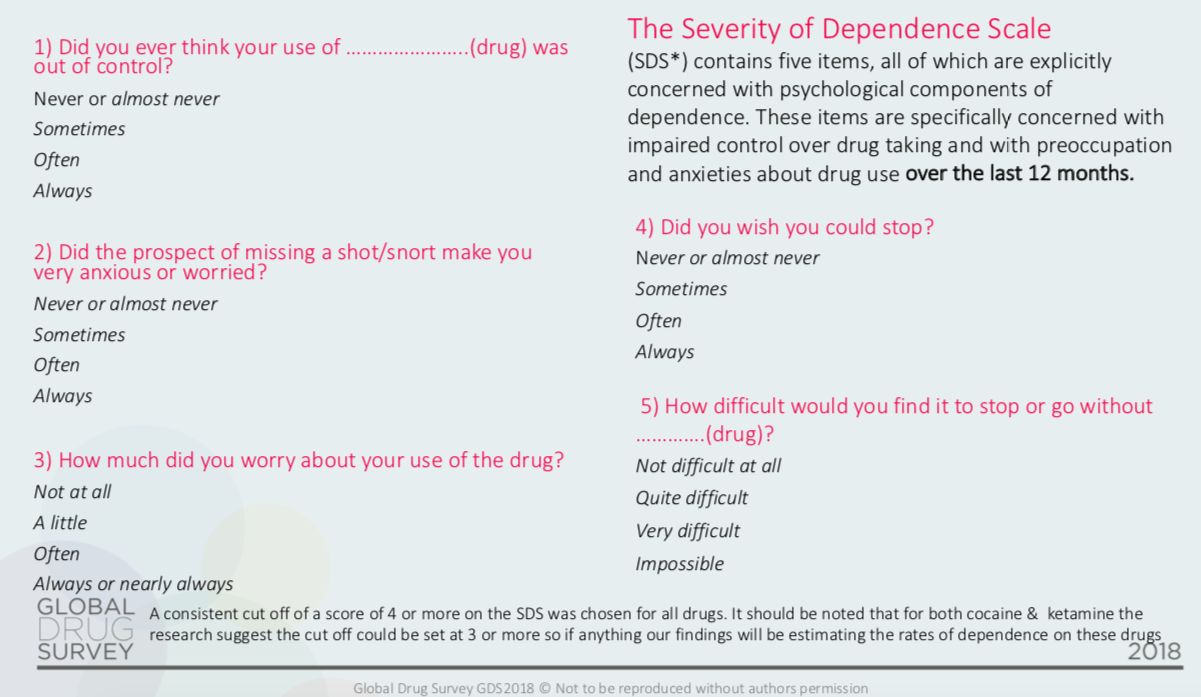A fifth of the dagga users responding to a global poll report signs of dependence, although cannabis appears to be one of the safest and most commonly used drugs overall, according to results released on Wednesday.
The findings are contained in the 2018 Global Drug Survey, a detailed questionnaire that compiled responses from more than 130,000 people in over 40 countries in the past year. One section of the survey used the Severity of Dependence Scale, or SDS — a tool that asks respondents five questions regarding impaired control over drug use and anxieties related to consumption and quitting.
Around 50,000 of the survey respondents reported having used marijuana in the past 12 months. Only alcohol and tobacco use were more common.
Of all cannabis users, 20.2 percent — the fifth-highest percentage among all the drugs polled — showed substantial signs of dependence, measured by affirmative answers to at least four of the five SDS questions. Crystal methamphetamine was the drug most closely associated with dependence, with nearly 25 percent of users scoring four or higher on the SDS.

A positive SDS score is not the same as a clinical diagnosis of dependence, Global Drug Survey founder Adam Winstock, a British addiction psychiatrist, stressed to HuffPost. But it does suggest that one in five marijuana users have serious misgivings about their habit.
"You've got 20 percent of the people who are significantly worried about the impact of their use on their life," said Winstock. "It's a measure of subjective worry and concern, but those questions tap into things like how much you use, how often, your sense of control and your desire to stop."
The responses to individual SDS questions offer a window into some of those feelings of dependence.
Cannabis was the substance most frequently associated with anxiety over the prospect of quitting, for example. Although nearly three-quarters of users said the idea of stopping "never or almost never" made them anxious, 19.7 percent said it "sometimes" did, with 5.3 percent reporting that it "often" or "always" did.
More than 72 percent of marijuana users said quitting would not be difficult, but a total of 21.4 percent said it would be "quite difficult" for them to stop using, with 6.4 percent responding that it would be either "very difficult" or "impossible".
Nearly 30 percent of users reported that their dagga use was at least occasionally "out of control", with 22.6 percent of respondents saying it was only "sometimes" an issue, 5.3 percent saying it was "often" an issue and 1.6 percent saying it was "always or nearly always" an issue.

The survey also sought to measure the overall safety of substances by asking respondents if they'd sought emergency medical treatment after using various drugs. Just 0.5 percent of all cannabis users reported seeking treatment after use, the second-lowest rate of any substance. Magic mushrooms appeared to be the safest recreational drug for the second year in a row, with just 0.2 percent of users saying they'd pursued medical intervention.
The cannabis dependence results were particularly surprising to Winstock, who said he would've expected to see around 10 to 15 percent of marijuana users report signs of dependence.
"You're legalising a drug that a fair number of people who use it have worries about themselves," Winstock said. "The question is what do you do about that?"
The Global Drug Survey may hold some answers. Since 2014, the independent research company has partnered with medical experts and media groups to conduct an annual survey with the goal of making drug use safer through increased access to education and treatment resources.
Around 300,000 marijuana users have partaken in Global Drug Surveys over the years, said Winstock. Those respondents have consistently shown high levels of support for establishing government guidelines around safe marijuana use. Among dagga users who have expressed a desire to use less frequently or quit entirely, many have said they'd like assistance in doing so. But very few end up seeking help.
You're legalising a drug that a fair number of people who use it have worries about themselves. The question is what do you do about that? Adam Winstock, founder of the Global Drug Survey
Taken together, the surveys suggest elected officials and the marijuana industry should be engaging in a more honest discussion about the risks associated with cannabis use, so they can better address issues that may arise as laws are liberalised, said Winstock.
"Clearly arresting someone and giving them a criminal record for smoking a joint is a futile and pointless exercise and ... nothing I'm suggesting is me saying cannabis is a bad drug and the government made a mistake," said Winstock, referring to U.S. states that have legalised cannabis.
"What I'm saying is that at the point they regulated cannabis, they should have mandated a whole bunch of things that allowed it to be easier for people to reflect on their cannabis use and how it impacted on them and how to control their use," he went on. "There should have been mandated health warnings and advice and an index of harm for different products."
Among the 3,400 U.S. marijuana users surveyed this year, just under 25 percent expressed a desire to use less ― compared to 29.3 percent of users globally. Just over 25 percent reported getting high more than 300 days out of the past year, though that may not be reflective of broader marijuana trends, because the survey didn't randomly sample users nationwide.
Sixteen percent of the American marijuana users who said they wanted to cut back also responded that they'd like help doing so. Nearly 50 percent of all U.S. users said they'd attempted to quit at some point, with 67 percent of those saying they'd tried in the previous year.
Winstock says it makes sense to increase access to harm-reduction tools in order to reach those who say they want help with their dependence on cannabis. But broad support for this sort of comprehensive approach requires people on all sides to confront the fact that marijuana, like pretty much any drug, can lead to dependence with some frequency.
Stop for a moment and think about how you cannot become the tobacco industry or the alcohol industry.Adam Winstock, founder of the Global Drug Survey
Instead, the legalisation debate has played out in a far more polarised fashion, with advocates often pushing back against decades of government anti-weed hysteria by claiming cannabis is a harmless drug, especially when compared to alcohol or tobacco.
In light of the cataclysmic failures of the nation's war on drugs, there is plenty of reason to be tempted by that portrayal.
"It could just be that so many people are saying we've raised billions in taxes, saved thousands of hours of police time, saved loads of innocent young lives from having their careers ruined and being banged up in prison," said Winstock. "Those are such huge wins that I could see people going, 'That's enough.'"
But just because the status quo has been so bad for so long and marijuana is less harmful than alcohol or tobacco ― legal drugs that kill more people each year than all illicit drugs combined ― doesn't mean the push to legalise cannabis can't learn from past mistakes.
For Winstock, it's not too late for legal weed states and leaders in the marijuana industry to place more focus on public health.
"Stop for a moment and think about how you cannot become the tobacco industry or the alcohol industry," said Winstock. "Be the best you can be, don't just make the biggest profit. Be the most responsible industry you can, and that means be honest."
Read the entire 2018 Global Drug Survey here.
